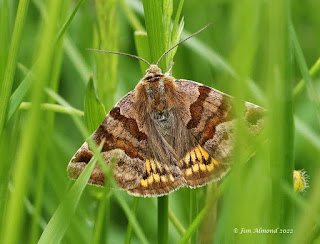Wednesday 22th June 2022, Treflach Farm
Our first outing of Summer was accompanied by extremely hot dry weather. Contrary to most of our outings this year there was not a drop of rain. However, by the end of the day, the relentless heat made me long for a short burst of cooling water from the sky! Are we never satisfied?
The visit took us to Treflach Farm. The farm is nestled in the hills above Llynclys quarry, and the Shropshire Wildlife Trust reserve at Sweeney Fen shares a part of its eastern flank.
We were greeted by the owner of the farm who provided us with information about the farm, how it had developed over the four generations of his family who had owned it, and his own philosophy of how it is now managed. More information about the farm can be found on their website: https://treflachfarm.co.uk/
An offer of lunch was made and accepted. A time was agreed and off we set.
The farm covers a large area but on the day we only managed to look at a small part of it. Most of the area that we spent our day in can be seen in the following photograph.
 |
| Photograph: David Williams |
(A reminder, if you need one, that selecting the photograph should open it in another window.)
As well as large expanses of meadows the farm includes a couple of gardens which are used for growing fruit and vegetables. A hint of one of the gardens can be seen in this photograph.
As you can tell from where the panorama was taken the only way is down, so down we went.
But not all.
Some seemed strangely addicted to the “high ground” and spent a lot of time searching that area.
Lots of Lucerne fleas had made their home amongst the clovers. These are not really fleas in the common understanding of fleas but tiny pale yellow/green springtails. Their scientific name is Sminthurus viridis. I must admit that Lucerne flea is easier to remember!
 |
| Photograph: David Williams |
Staying with the tiny theme, here are a couple of minute snails that will only be found by dedicated searching of the vegetation.
The first has a wonderful common name, the Eccentric grass snail.
 |
| Photograph: Mags Cousins |
I am not sure what makes it eccentric but it could be its scientific name which has expanded somewhat from the normal two word format to "Vallonia cf. excentrica sensu Anderson 2008"! I am sure it will be shortened when dropped into a conversation.
However, according to the NatureSpot website NatureSpot - Eccentric grass snail eccentric refers to the shape of its shell and umbilicus (the hole within the shell).
The second snail is the Blind snail, Ceciloides acicula.
 |
| Photograph: Mags Cousins |
Another observation that was made as the result of detailed hand searching was the larva of a weevil encased in a lattice like structure.
 |
| Photograph: Mags Cousins |
Very brief research on the internet has drawn a blank on the purpose of the lattice, but my assumption is that it is a defence mechanism in a similar way that “cuckoo-spit” is for some larvae of planthoppers.
A few members of the group had made it to the pool at the bottom of the site. Here, within the vegetation that surrounded the pool we found one of the larger inconspicuous ladybirds Coccidula rufa.
 |
| Photograph: David Williams |
It was quickly discovered that the vegetation around the pool was home to lots and lots of toadlets, so you had to be very careful where you put your feet!
I lagged a long way behind the advance party and by the time I had made it to the pool it was time for lunch.
Normally I would declare where I was as the site for lunch, but on this occasion lunch was in a building by the car park! So up the hill we stomped, meeting others on the way who had already decided it was time for a rest.
For lunch we were given baked potatoes, a selection of pies (what a shame our pie aficionado was unable to join us for the day), salad and various drinks. All of the food and drinks had been grown, collected or produced on the farm.
An excellent lunch.
Anything after that was going to be an anti-climax!
Lunch over it took a great effort to tear ourselves away and carry on our survey.
We returned down the hill, perhaps a little more wary of the effort that would be required later to get back up.
Passing a larch on the way we paused to see what creatures it held. One of the insects found was the larva of a Larch ladybird.
 |
| Photograph: David Williams |
Down we went.
Eventually reaching the pool.
Some time was spent investigating the vegetation of the wet meadow that surrounded the pool before the heat and passage of time drew the day to a close.
Returning to the cars we found an animal for which, unfortunately, life had reached its inevitable end. A shrew, probably a Pigmy shrew, based on the length of its tail.
 |
| Photograph: Mags Cousins |
Despite this we had an excellent day on an excellent site.
My thanks to the owner of Treflach Farm for giving us permission to do what we enjoy doing and sustaining us so well during a very hot day. As always my appreciation to the photographers for providing their excellent images.
.JPG)
.JPG)
.JPG)
.JPG)



%202022-06-15.JPG)
.JPG)
.JPG)

%202022-06-15.JPG)









.jpg)
.jpg)
.jpg)









.JPG)









.jpg)
.jpg)

.JPG)




















